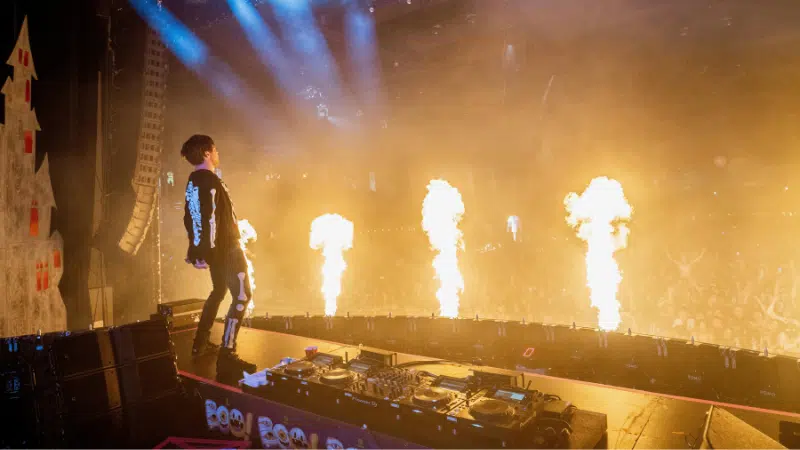Most artists are out here creating content, dropping music, and hoping for the best. And while that grind is admirable, true marketers are playing an entirely different game. They’re mapping out every step a fan takes from “just heard of you” to “omfg can’t stop streaming, bought the vinyl, and drove five hours to your show.”
And that’s the difference… Marketers think in terms of the entire fan journey to support their efforts. Once you understand it, you can start using it to guide your own fans from casual listeners to lifelong supporters. In this post, we’re breaking down everything you need to know to level up your game from guesswork to true strategy. Let’s dive in…
The Fan Journey Breakdown: What Marketers Know That Most Artists Miss
What is a Fan Journey?
The “fan journey” is the emotional path someone takes from discovering your music to becoming a full-blown fan. It’s less about the music itself and more about every interaction that builds trust, connection, and loyalty along the way.
In the marketing realm, we call this a “customer journey”. In the music world, we’re talking about the fans. When you understand this journey, you stop treating every fan the same and meet them where they’re at. The fan journey can be broken into three general stages:
- New Fan: These fans just found you. Maybe through a TikTok, a playlist, a tag on IG. They don’t know much about you yet.
- Casual Fan: They’re following you now. They like a few songs, maybe watched a video or two, but they’re not checking for every drop.
- Core Fan: These fans are your day-ones. They buy your merch, comment on everything, share your music with their friends, and show up to shows.
Every fan starts as “new”, but it’s your job to help them level up. Once you know where your fans are in their journey, you can start creating the right content and experiences to move them forward. No guesswork here; only actionable insights.
Mapping Content by Stage
Surprise! Not all fans want (or need) the same thing at the same time. That’s why tailoring your content to each stage of the fan journey works wonders. New Fans are just getting to know you; they need eye-catching visuals, short intro videos, and playlist features to reel them in to take a closer look. This is your chance to make a strong first impression and hook these viewers. Platforms like TikTok, YouTube Shorts, Instagram Reels, and Spotify playlists are key discovery zones; this is where new fans are most likely to find you, so make sure you’re showing up with scroll-stopping content.
Casual Fans have some interest, but they aren’t fully invested yet. Now’s the time to deepen that connection with behind-the-scenes clips, regular updates, and calls-to-action like signing up for your email list or following your socials. (PRO TIP: If you want to maximize your reach without overloading yourself with work, consider repurposing your existing video content across multiple platforms. Check out “7 Places to Share Repurposed Video Content” for some of our favorite time-saving ideas.)
Lastly, your Core Fans are your ride or dies. They want exclusives like early merch drops, private livestreams, meet and greet invites, etc. to feel valued. And building that community around your music is what turns those fans into advocates. No longer are we shouting into the void and hoping for the best! Match your content to your fans’ needs, and you’ll start to see real results, real fast… That’s the beauty of smart marketing.
Segmenting Your Fans
Now that we understand that not all fans are created equal, treating them like they are is wasting valuable time and energy. This is where the power of segmentation comes in, aka grouping your fans based on real data like where they live, how they engage, and which platforms they prefer. This helps you send the right message to the right people at the right time. But how do you find that data?
📍 Location: Use analytics tools on platforms like Instagram Insights, Facebook Audience Insights, and Spotify for Artists to see where your listeners are based. This info is gold for planning tours, targeted ads, or localized content.
🧠 Behavior: Look at who’s streaming your songs most often, who’s saving your music to playlists, or who regularly opens your emails. Platforms like Spotify for Artists show listener habits, while email tools provide open and click rates.
📱 Platform Preferences: Check which social channels get the most engagement from your fans. Instagram, TikTok, YouTube, and Facebook all offer insights into where your audience spends the most time. And with the new launch of TikTok for Artists, you now have access to even deeper analytics around follower growth, engagement, and content performance, helping you shape your strategy specifically for your audience on that platform.
Segmenting lets you tailor your messages to these specific groups. For example, Spotify for Artists shows you where your top listeners are based, so if you see a strong hometown audience, you can target them with early show invites. On the other hand, your TikTok audience might respond better to exclusive platform-specific content like challenges or behind-the-scenes clips.
——
👀 Want something extra?
Everything You Need To Know About YouTube for Artists
How To Turn One Release Into an Evergreen Content Strategy
How to Protect Your Mental Health on Social Media as an Artist
Sync Licensing for Indie Labels: How to Prep Your Catalog the Right Way
——
Let’s Talk About Retargeting
Retargeting is exactly what it sounds like: following up with people who’ve already shown interest in you. Instead of constantly bombarding new fans, retargeting helps you re-engage with the ones who have already interacted with your content. Whether they visited your website, watched your music video, opened your email, or liked a post but didn’t hit follow, you can reengage them through retargeting. Here’s what you can do:
- Ads: Platforms like Instagram, Facebook, TikTok, and YouTube let you build custom audiences based on fan activity like who watched a video, clicked a link, or engaged with a post. You can then run ads specifically for those people to bring them back in.
- Email: Most email platforms (like ConvertKit or Mailchimp) let you resend messages to people who didn’t open them the first time, or send targeted follow-ups based on location or link clicks, perfect for things like tour stops or merch drops.
- DMs & Comments: This one’s free and underrated. Go through your story replies, post comments, or DMs, and engage with fans who are already showing love. A quick reply or thank-you can make a fan feel seen and keep them coming back.
It’s not about being spammy, it’s about being intentional. If you can grab someone’s attention, give them a reason to let you keep it!
How To Keep Track of Everything
Once you start segmenting and retargeting your fans, you’re going to want a way to keep track of everything, i.e. what you’ve done, what’s working, and what still needs attention. That’s where fan management tools come in. You don’t need to be a tech genius to use these, either. There are plenty of artist-friendly platforms that make it easy to stay organized and intentional.
Kit (formerly ConvertKit) is a strong option for building and managing your email list. It offers tagging, segmentation, and automations so you can track who opens your emails, what they click, and send targeted follow-ups based on real fan behavior. Bandsintown for Artists is ideal if you’re performing live. It lets you message fans based on their location, promote shows using smart targeting, and grow your mailing list while doing it. If you’re just getting started, Mailchimp and Substack are great entry-level tools. Mailchimp is perfect for basic email campaigns and audience tracking, while Substack is better suited for artists who like to share long-form updates, storytelling, or personal notes alongside their releases.
No matter which platform you choose, the goal is the same. Stay connected, stay organized, and give your fans a more personal experience at every stage of their journey.
To wrap things up…
Understanding the fan journey gives you the tools to stop guessing and start building real momentum. When you know how to segment your audience, retarget the right people, and stay organized with the right tools, you’re not just promoting your music, you’re building a fanbase that actually lasts. Use your next release as a test run! Apply one tip from this post and watch how your fans respond.
Good luck!



